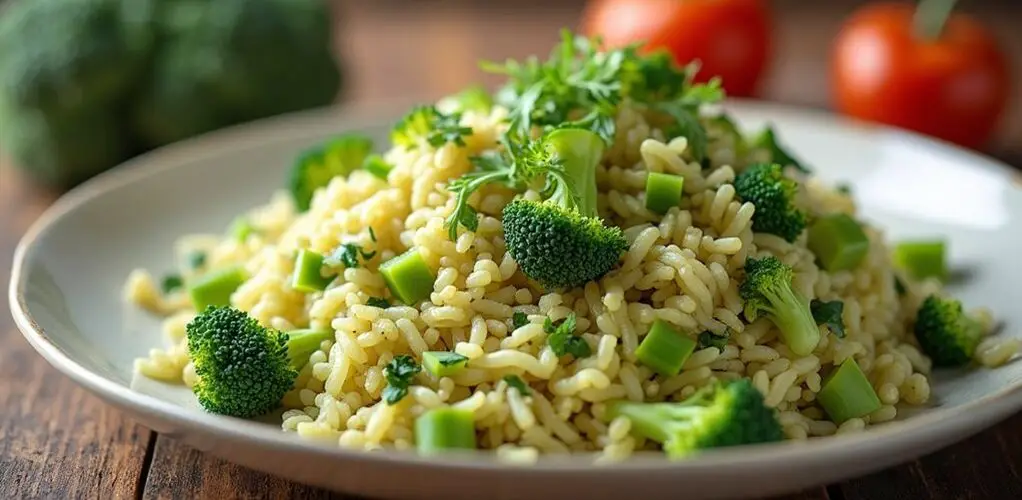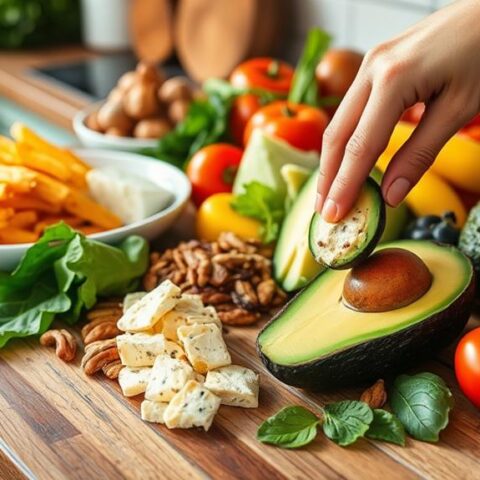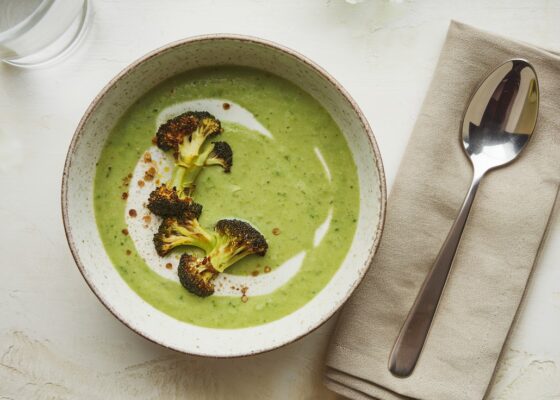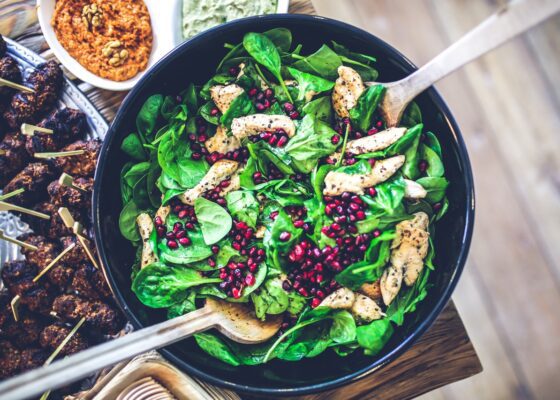
Rice poses a challenge for low-carb diets due to its substantial carbohydrate content, with most varieties containing 35-50 grams per cup. White rice contains approximately 45 grams of carbs per cup, while brown rice has slightly more at 50-52 grams. Low-carb alternatives like cauliflower rice (5 grams) or shirataki rice (zero carbs) offer viable substitutions. While rice can be included in moderation through careful portion control, understanding its impact on blood sugar helps create effective dietary strategies.
Key Takeaways
- Rice is generally challenging for low-carb diets, with most varieties containing 39-52 grams of carbohydrates per cup.
- Portion control is essential – limiting rice to 1/4 cup servings provides about 11-12 grams of carbs.
- Low-carb alternatives like cauliflower rice (5g carbs) or shirataki rice (0g carbs) offer better options.
- Combining rice with proteins and fats helps moderate blood sugar impact when consumed occasionally.
- Brown rice's higher fiber content (3.5g vs 1g) makes it slightly better than white rice for low-carb diets.
Understanding Rice's Carbohydrate Content
Rice stands as a dietary staple worldwide, but its significant carbohydrate content presents a challenge for those following low-carb eating plans. A single cup of cooked white rice contains approximately 45 grams of carbohydrates, while brown rice contains even more at 50 grams per cup, classifying both as high-carb food choices that can quickly impact daily carbohydrate intake limits.
For individuals committed to low-carb diets, understanding these numbers is essential for meal planning. While some low-carb eating plans may accommodate small portions of rice, many people opt for alternatives like cauliflower rice, which contains only 5 grams of carbohydrates per cup.
This significant difference in carbohydrate content makes cauliflower rice a more suitable option for maintaining low-carb dietary goals.
Different Types of Rice and Their Carb Counts
When comparing white and brown rice, their carbohydrate content remains similarly high at approximately 45 and 44 grams per cooked cup respectively, though brown rice offers additional nutritional benefits.
For those following strict low-carb diets, cauliflower rice presents a compelling alternative with only 5 grams of carbohydrates per cup, while wild rice provides a middle-ground option at 35 grams per cup.
Popular varieties like jasmine and basmati rice mirror white rice's carbohydrate content, containing about 45 grams per cooked cup, making them equally challenging to incorporate into low-carb meal plans.
White Vs Brown Rice
Understanding the differences between white and brown rice is essential for anyone following a low-carb diet, as both varieties present similar challenges in carbohydrate management.
Both white rice and brown rice contain approximately 45 grams of carbohydrates per cooked cup, making them equally challenging for those monitoring their carb intake.
While brown rice offers a slight nutritional advantage with its 3.5 grams of fiber per cup, reducing the net carb count, both types generally exceed the limits of strict low-carb diets.
For those unwilling to completely eliminate rice, careful portion control may allow for occasional consumption.
However, those seeking to maintain stricter carbohydrate limits might consider alternatives like cauliflower rice, which contains only about 5 grams of carbs per cup.
Carbs Per Serving Size
Different varieties of rice present distinct carbohydrate profiles that require careful consideration when following a low-carb diet.
Standard white rice and jasmine rice contain approximately 45 grams of carbs per serving size, while brown rice follows closely with 44 grams, making them all high-carb food choices.
Basmati rice offers a slightly lower carbohydrate content at 39 grams per cup, though it remains challenging to incorporate into low carbohydrate diets.
For those seeking a substitute for low-carb diet plans, consider these alternatives:
- Cauliflower rice provides only 5 grams of carbs per cup
- A single portion of white or brown rice can exceed daily carb limits on strict low-carb plans
- Measuring portions precisely helps track carbohydrate intake when incorporating rice occasionally
Alternative Rice Options
Although traditional rice varieties present challenges for low-carb dieters, several alternative options provide satisfying substitutes while maintaining notably lower carbohydrate counts.
Cauliflower rice stands out as a popular choice, containing just 5 grams of carbohydrates per cup compared to white rice's 45 grams. Shirataki rice, derived from konjac root, offers an even lower-carb alternative with virtually zero carbohydrates, making it ideal for strict low-carb eating plans.
For those seeking variety in their rice alternatives, riced zucchini presents another excellent option with only 4 grams of carbohydrates per cup.
These alternatives not only remarkably reduce carbohydrate intake but also add nutritional diversity to meals, allowing individuals following low-carb diets to enjoy rice-like dishes without compromising their dietary goals.
White Rice vs. Brown Rice: A Nutritional Comparison
While both white and brown rice are staples in many diets worldwide, their nutritional profiles differ greatly when it comes to carbohydrate content and overall health benefits.
Brown rice contains slightly more carbohydrates at 52 grams per cup compared to white rice's 45 grams, but its higher fiber content of 3.5 grams helps offset the impact on blood sugar levels.
Despite having more carbs than white rice, brown rice's extra fiber helps minimize its effects on blood sugar.
The glycemic index also varies considerably, with white rice scoring 73 and brown rice measuring 50.
Key considerations for low carb dieters:
- Brown rice offers more nutritional value with its intact bran and germ layers
- The higher fiber content in brown rice results in lower net carbs
- Both varieties should be consumed in moderation due to their substantial carbohydrate content and potential to raise blood sugar levels
The Impact of Rice on Blood Sugar Levels
Both white and brown rice greatly affect blood glucose levels, with white rice's high glycemic index of 73 triggering more pronounced insulin responses compared to brown rice's moderately high index of 68.
The rapid conversion of rice's abundant carbohydrates into glucose can lead to notable post-meal blood sugar spikes, particularly when consumed in larger portions.
Understanding these blood sugar impacts becomes essential for individuals following low-carb diets or managing diabetes, as even the healthier brown rice variant requires careful portion control to maintain stable glucose levels. It's also important to consider diets like the ketogenic diet, which can significantly reduce blood glucose levels and enhance insulin sensitivity, as potential alternatives for better blood sugar management.
Glycemic Index Comparison
Understanding how rice affects blood sugar levels is vital for anyone following a low-carb diet. Different types of rice have varying glycemic index ratings, with white rice typically scoring higher (73) compared to brown rice (68). This difference greatly impacts how quickly blood sugar levels rise after consumption.
- Cooking methods can alter rice's glycemic impact, with al dente preparation resulting in a lower glycemic response.
- Combining rice with protein and healthy fats slows carbohydrate absorption, reducing blood sugar spikes.
- Portion control remains essential, as even lower-GI rice varieties can affect blood sugar levels when consumed in large amounts.
The glycemic index of rice ranges from 55 to 93, making it important to take into account not just the type of rice consumed, but also how it's prepared and what it's paired with during meals.
Insulin Response Patterns
How rice affects insulin levels presents an important consideration for individuals following a low-carb diet. The carbohydrate content in cooked white rice triggers a significant insulin response, with blood sugar levels rising rapidly after consumption. Understanding these patterns is vital for managing carbohydrate intake effectively.
| Factor | Impact on Insulin Response |
|---|---|
| White Rice | High, immediate spike |
| Brown Rice | Moderate, gradual increase |
| Portion Size | Directly proportional rise |
| Meal Timing | Peak within 30-60 minutes |
| Protein/Fat Addition | Reduced glucose absorption |
The inclusion of protein and healthy fats while consuming rice can help modulate the insulin response by slowing glucose absorption into the bloodstream. This strategy proves particularly beneficial for those seeking to maintain stable blood sugar levels while following a low-carb diet plan.
Post-Meal Glucose Spikes
The direct correlation between rice consumption and post-meal glucose spikes presents significant challenges for individuals following a low-carb dietary approach.
Both white and brown rice contain substantial carbohydrates, with white rice's high glycemic index of 73 causing particularly rapid blood sugar elevations. While brown rice offers marginally better numbers, its 40 grams of carbs per cup still impacts glucose levels considerably.
- Combining rice with proteins and fats can help moderate blood sugar response
- Strict portion control is essential when incorporating rice into a low carb diet
- Substituting rice with low-carb vegetables like cauliflower rice provides a practical solution for blood sugar management
Understanding these impacts enables better decision-making for those prioritizing stable glucose levels while maintaining their dietary preferences.
Portion Control Strategies for Rice Consumption
Successfully managing rice consumption on a low-carb diet requires precise portion control strategies, as even modest servings can quickly deplete daily carbohydrate allowances.
To effectively maintain carb intake within acceptable limits, individuals should measure rice portions to approximately 1/4 cup per serving, which contains roughly 11-12 grams of carbohydrates.
Implementing proper meal planning techniques can help balance rice consumption with other dietary components. Using measuring cups or a food scale guarantees accurate tracking portions, while incorporating protein-rich foods and vegetables helps create satisfying meals with controlled carb content.
For those seeking lower-carb alternatives, substituting traditional rice with cauliflower rice or shirataki rice provides similar textural experiences while greatly reducing carbohydrate intake, making these options particularly valuable for low-carb dieters.
Low-Carb Rice Alternatives and Substitutes
While traditional rice poses challenges for those following low-carb diets, numerous alternatives provide similar culinary experiences without the considerable carbohydrate content.
Following a low-carb diet doesn't mean giving up rice-like dishes, as modern alternatives deliver similar experiences with significantly fewer carbohydrates.
For those seeking to reduce their carbohydrate intake, options like cauliflower rice, shirataki rice, and zucchini rice offer practical solutions with markedly fewer carbs per serving. These rice alternatives can seamlessly integrate into various recipes while supporting low-carb dietary goals.
- Cauliflower rice contains only 5 grams of carbs per cup, compared to white rice's 45 grams.
- Shirataki rice provides a virtually zero-carb option, making it ideal for strict low-carb diets.
- Vegetable-based alternatives like zucchini and broccoli rice add nutritional benefits while keeping carbs low.
Additionally, zucchini noodles are a popular choice, offering just 3g of carbs per 3.5oz serving, making them a versatile option for those on keto or low-carb diets.
These substitutes enable individuals to maintain their low-carb lifestyle without sacrificing the satisfying texture and versatility of traditional rice dishes.
Calculating Net Carbs in Rice Dishes
Understanding net carbs plays an essential role in managing rice consumption within a low-carb dietary framework. To calculate net carbs in rice dishes, subtract the fiber content from total carbohydrates. For white rice, with approximately 45 grams of carbs and only 1 gram of fiber per cup, the net carb count remains remarkably high at 44 grams.
When following a low-carb diet, this calculation reveals why portion control becomes vital for rice consumption. Given these numbers, many people opt for alternatives to rice, such as cauliflower rice or shirataki rice, which provide considerably lower carbohydrate intake while maintaining a similar dining experience.
For those who choose to include traditional rice, measuring portions carefully and considering the impact on daily carb limits is essential for staying within dietary goals.
Rice and Weight Loss Goals
Managing weight loss goals on a low-carb diet requires careful consideration of rice consumption and its impact on daily carbohydrate limits. With one cup of cooked rice containing approximately 45 grams of carbs, incorporating this grain regularly can quickly derail weight loss efforts by consuming a significant portion of the recommended daily carb allowance. To successfully achieve weight loss while following a low carb diet, consider these key strategies:
- Replace traditional rice with cauliflower rice to reduce carb intake while maintaining familiar meal portions.
- Focus on non-starchy vegetables and protein sources to promote satiety and support weight management.
- If including rice, limit portions to occasional small servings and adjust other daily carb sources accordingly. The ketogenic diet's enhanced insulin sensitivity reduces hunger and cravings, which can be beneficial in managing rice consumption on a low-carb diet.
Best Practices for Including Rice in a Low-Carb Diet
Successful incorporation of rice into a low-carb diet requires specific strategies and thoughtful planning to maintain carbohydrate restrictions while enjoying this popular grain. A key approach is implementing strict portion control, limiting rice servings to a quarter cup or less per meal.
For more flexibility, individuals can opt for rice alternatives such as cauliflower rice, which contains considerably fewer carbohydrates while providing essential fiber and nutrients.
To optimize rice consumption on a low carb diet, pairing it with protein-rich foods and fiber-filled vegetables helps regulate blood sugar levels. Additionally, utilizing the resistant starch method by cooking and cooling rice can reduce its impact on blood glucose.
Strategic pairing of rice with proteins and vegetables, plus the resistant starch cooking method, helps maintain stable blood sugar on low-carb diets.
This technique, combined with mindful portions and strategic meal planning, allows for occasional rice enjoyment while maintaining low-carb dietary goals.
Meal Planning Tips When Eating Rice
While incorporating rice into a low-carb meal plan requires careful attention, strategic planning can make it both manageable and enjoyable. Successful meal prep begins with portion control, carefully measuring half-cup servings of whole grain rice to maintain proper carb intake.
Combining rice with high-protein foods and non-starchy vegetables creates balanced meals that support blood sugar control while providing satisfying nutrition.
- Prepare rice portions in advance and store them in individual containers for easy tracking and convenience throughout the week.
- Consider substituting traditional rice with cauliflower rice in some meals to greatly reduce carbohydrate content.
- Create balanced plates by filling half with non-starchy vegetables, one-quarter with protein, and one-quarter with measured rice portions.
To ensure optimal nutritional benefits and adherence to a keto diet, focus on incorporating low-carb vegetables like spinach and broccoli alongside your rice dishes.
Common Myths About Rice and Low-Carb Diets
Despite the growing popularity of low-carb diets, several persistent myths about rice consumption continue to circulate among health-conscious individuals.
One common misconception is that all types of rice contain equal amounts of carbohydrates, when in fact brown rice offers slightly lower net carbs than white rice.
Another myth suggests that rice can be easily incorporated into low-carb diets in moderation, yet even small portions can quickly exhaust daily carb allowances, particularly on strict regimens like keto.
Despite claims of moderation, rice's high carb content makes it challenging to fit into low-carb diets, especially ketogenic meal plans.
Many dieters also incorrectly assume that riced cauliflower requires identical portion sizes as regular rice, overlooking its considerably lower carb content of just 5 grams per cup.
Additionally, the belief that all grains are suitable for low-carb diets disregards how refined grains like rice can impact blood sugar levels.
Cultural Considerations and Rice Consumption
The role of rice in traditional diets presents a significant challenge for individuals pursuing low-carb lifestyles while maintaining cultural connections.
Global cuisines offer numerous creative alternatives, from cauliflower rice in Asian dishes to zucchini noodles in Mediterranean preparations, allowing people to adapt ancestral recipes without completely abandoning familiar flavors and textures.
Finding balance between honoring cultural heritage and achieving health goals often requires thoughtful meal planning, open communication with family members, and gradual adaptation of traditional recipes to accommodate lower-carb ingredients.
Rice in Traditional Diets
Since ancient times, rice has maintained its position as a cornerstone of traditional diets across diverse cultures, particularly in Asian, Latin American, and African societies.
As a high-carb food containing approximately 45 grams of carbohydrates per cooked cup, rice plays a vital role in providing energy in traditional diets while being balanced with other nutritional components for ideal health.
Key aspects of rice in traditional dietary practices:
- Serves as both a primary carbohydrate source and a cultural symbol of prosperity and hospitality.
- Functions within a broader framework of balanced nutrition, typically paired with proteins and vegetables.
- Demonstrates the effectiveness of moderation in traditional diets, where high-carb foods are integrated thoughtfully with other food groups.
Global Rice Alternative Options
Modern dietary trends have prompted a global exploration of rice alternatives, reflecting both health consciousness and cultural adaptations. Global cultures are embracing vegetable-based alternatives to accommodate low-carb diet preferences while preserving traditional recipes. Cauliflower rice has emerged as a leading substitute, particularly in Asian and Latin American cuisines.
| Region | Traditional Rice Dish | Low-Carb Alternative |
|---|---|---|
| Asia | Stir-Fried Rice | Cauliflower Fried Rice |
| Latin America | Spanish Rice | Seasoned Riced Vegetables |
| Mediterranean | Rice Pilaf | Spiralized Vegetable Medley |
These health-conscious adaptations demonstrate how traditional cooking methods can evolve to meet contemporary dietary needs while maintaining cultural authenticity. The growing availability of these alternatives has made it easier for individuals following a low-carb diet to enjoy familiar flavors and textures.
Balancing Heritage With Health
Maneuvering between cultural traditions and modern dietary needs presents a significant challenge for individuals seeking to maintain their heritage while following a low-carb lifestyle.
Managing carbohydrate intake while respecting cultural practices requires thoughtful adaptation of traditional rice-based dishes. Those pursuing a low carb diet can embrace their heritage through strategic portion control and creative alternatives, ensuring meaningful connections to cultural identity remain intact.
- Incorporate smaller portions of traditional rice dishes during special cultural celebrations while maintaining stricter alternatives during regular meals.
- Experiment with cauliflower rice or shirataki rice in family recipes, preserving familiar flavors and cooking methods.
- Consider brown rice as an occasional compromise, offering better nutritional value when cultural authenticity is essential.
Scientific Research on Rice and Carbohydrates
Scientific studies have extensively documented rice's carbohydrates composition and its metabolic effects on the human body. Research demonstrates that both white and brown rice contain significant carbohydrate content, with glycemic index values that can impact blood sugar levels substantially. Studies on resistant starch formation through cooling have shown promising results for improving rice's net carb count and digestive benefits.
| Type | Carbs/Cup | GI Range | Benefits | Considerations |
|---|---|---|---|---|
| White Rice | 45g | 70-90 | Easy to digest | High blood sugar impact |
| Brown Rice | 52g | 65-85 | Higher fiber | More nutrients |
| Cooled Rice | 45-52g | Lower | Resistant starch | Storage needed |
| Cauliflower Rice | <5g | Very low | Low-carb friendly | Different texture |
| Shirataki Rice | <1g | Minimal | Lowest carb option | Unique consistency |
Preparing Rice to Reduce Carb Impact
While traditional rice preparation methods can result in high carbohydrate absorption, several evidence-based techniques can help reduce the overall carb impact without sacrificing the enjoyment of this staple food.
Research indicates that soaking rice before cooking and cooling it after preparation can increase resistant starch content and lower glycemic index. Additionally, using a rice cooker with steaming capabilities creates fluffier rice while potentially reducing its carbohydrate load.
Soaking and cooling rice creates beneficial resistant starch, while steam cooking produces lighter, less carb-heavy results.
- Switch to brown rice for increased fiber content and improved digestive benefits
- Implement a pre-cooking soak of several hours to break down starches naturally
- Consider incorporating cauliflower rice as a low-carb alternative that maintains similar texture and versatility in recipes
These preparation methods, combined with mindful portion control, can help maintain a lower carbohydrate intake while still enjoying rice-based dishes.
Frequently Asked Questions
Can I Still Eat Rice in a Low-Carb Diet?
Rice consumption on low-carb diets requires careful portion control. Consider low-glycemic alternatives and rice substitutes like cauliflower rice. Proper meal planning helps incorporate minimal rice while maintaining health benefits.
What's the Worst Carb for Belly Fat?
Refined sugars and processed foods rank as the worst carb sources for belly fat accumulation. These trigger significant insulin spikes, promoting fat storage. Portion control and choosing healthy alternatives help minimize this effect.
What Is the Number One Carb to Avoid?
When carb counting, refined white rice stands as the number one carb to avoid, containing 45g per cup. Complex carbs and fiber-rich substitutes offer healthier alternatives for low carb sources.
Can You Eat Rice on a Slow Carb Diet?
Rice should be avoided on a slow carb diet. Instead, focus on rice alternatives, careful carb counting, and portion control. Choosing low glycemic index options and proper cooking methods maximize nutritional benefits during meal planning.
Conclusion
While rice can be included in a low-carb diet, careful portion control and preparation methods are essential. Understanding the carbohydrate content of different rice varieties, along with their glycemic impact, enables informed dietary choices. Alternative cooking methods and mindful serving sizes can help minimize carbohydrate intake while still enjoying this staple food. For those following strict low-carb diets, rice should be limited or replaced with lower-carb alternatives like cauliflower rice.










No Comments